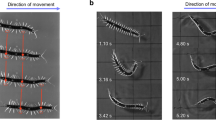Summary
-
1.
Removal of the myochordotonal organ from one or two walking legs produces no measurable differences in the mero-carpopodite (M-C) joint movements in those legs during walking.
-
2.
Removal of the myochordotonal organs from all the walking legs produces a pronounced hyperflexion of the M-C joints of all the leading legs (20 to 50 degrees) and a slight hyperflexion of the trailing legs (10 to 20 degrees).
-
3.
Animals with all myochordotonal organs removed were still able to walk against an applied load.
-
4.
Animals from which myochordotonal organs had been removed walked more slowly than intact animals. The operated animals reacted to applied loads by increasing the firing frequency of the excitatory motoneurons to the power-stroke muscles.
-
5.
Removal of the myochordotonal organs did not cause any change in the maximum frequency of motor output to powerstroke muscles. It was concluded that the myochordotonal organs do not function in the response to increased load, but do determine the end point of the flexion stroke.
Similar content being viewed by others
References
Barnes, W.J.P., Spirito, C.P., Evoy, W.H.: Nervous control of walking in the crab,Cardisoma guanhumi. II. Role of resistance reflexes in walking. Z. vergl. Physiol.76, 16–31 (1972).
Clarac, F., Wales, W., Laverack, M. S.: Stress detection at the autotomy plane in the decapod Crustacea. II. The function of receptors associated with the cuticle of the basi-ischiopodite. Z. vergl. Physiol.73, 383–407 (1971).
Cohen, M.J.: The crustacean myochordotonal organ as a proprioceptive system. Comp. Biochem. Physiol.8, 223–243 (1963).
Cohen, M.J.: The dual role of sensory systems: detection and setting central excitability. Cold Spr. Harb. Symp. quant. Biol.30, 587–599 (1965).
Euler, C. von: Proprioceptive control in respiration. Motor control of muscle afferents, R. Granit, ed., p. 197–207. Stockholm: Almquist & Wiskell 1966.
Evoy, W.H., Cohen, M.J.: Central and peripheral control of arthropod movements. Advanc. comp. Physiol. Biochem.4, 225–266 (1971).
Evoy, W.H., Fourtner, C.R.: Nervous control of walking in the crab,Cardisoma guanhumi. III. Proprioceptive influences on intra- and intersegmental coordination. J. comp. Physiol.83, 303–318 (1973).
Fields, H.L., Kennedy, D.: Functional role of muscle receptor organs in crayfish. Nature (Lond.)206, 1232–1237 (1965).
Kennedy, D.: The control of output by central neurons. The interneuron, M.A.B. Brazier, ed., p. 21–36. Los Angeles: University of California Press 1969.
Pearson, K.G.: Central programming and reflex control of walking in the cockroach. J. exp. Biol.56, 173–193 (1972).
Phillips, C.G.: Motor apparatus of the baboon's hand. Proc. roy. Soc. B173, 141–174 (1969).
Spirito, C.P., Evoy, W.H., Barnes, W.J.P.: Nervous control of walking in the crab,Cardisoma guanhumi. I. Characteristics of resistance reflexes. Z. vergl. Physiol.76, 1–15 (1972).
Usherwood, P.N.R., Runion, H.I., Campbell, J.I.: Structure and physiology of a chordotonal organ in the locust leg. J. exp. Biol.48, 305–323 (1968).
Wendler, G.: The coordination of the walking movements in arthropods. Symp. Soc. exp. Biol.20, 229–249 (1966).
Author information
Authors and Affiliations
Additional information
This work was supported by NSF grant GB30605 to W.H.E. and a post-doctoral fellowship to C.R.F. on NIH Training Grant HD00187 to the Laboratory for Quantitative Biology. We thank Penelope Melvin for her technical assistance throughout the course of this study.
Rights and permissions
About this article
Cite this article
Fourtner, C.R., Evoy, W.H. Nervous control of walking in the crab,Cardisoma guanhumi . J. Comp. Physiol. 83, 319–329 (1973). https://doi.org/10.1007/BF00693682
Received:
Issue Date:
DOI: https://doi.org/10.1007/BF00693682




